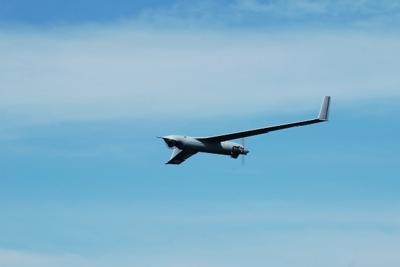Wed, Jun 11, 2014
Research To examine UAS Integration With ATC Procedures And NextGen
The FAA has announced that the State of Nevada’s unmanned aircraft systems test site is ready to conduct research vital to integrating UAS into the nation’s airspace. Nevada is the third of six congressionally mandated test sites to become operational.

“Nevada has been on the leading edge of aerospace flight testing for almost 70 years,” said Transportation Secretary Anthony Foxx. “Today, the state continues that tradition by contributing to the safe and efficient integration of unmanned aircraft into the U.S. aviation system.”
The FAA granted the State of Nevada team a two-year Certificate of Waiver or Authorization (COA) to use an Insitu ScanEagle at the Desert Rock Airport located in Mercury, NV. Desert Rock Airport, owned and operated by the Department of Energy, is a private airport and not for general use. The ScanEagle will fly at or below 3,000 feet, monitored by a visual observer and mission commander. Initial flights will verify that a UAS can operate safely at the airport.
Nevada’s research will concentrate on UAS standards and operations as well as operator standards and certification requirements. The site’s activities also will include a concentrated look at how air traffic control procedures will evolve with the introduction of UAS into the civil environment and how these aircraft will integrate with NextGen, the modernization of the national airspace system.
“The UAS test sites will help us identify operational goals as well as safety issues we must consider when expanding the use of unmanned aircraft into our airspace,” said FAA Administrator Michael Huerta. “This industry is growing exponentially, and we are working hard to make sure it does so safely.”
The FAA selected six congressionally-mandated test sites on December 30, 2013. The agency is working with the test sites to guide their research programs to help the FAA safely integrate UAS into the national airspace over the next several years.
(ScanEagle UAV pictured in file photo)
More News
He Attempted To Restart The Engine Three Times. On The Third Restart Attempt, He Noticed That Flames Were Coming Out From The Right Wing Near The Fuel Cap Analysis: The pilot repor>[...]
Make Sure You NEVER Miss A New Story From Aero-News Network Do you ever feel like you never see posts from a certain person or page on Facebook or Instagram? Here’s how you c>[...]
From 2009 (YouTube Edition): Leading Air Show Performers Give Their Best Advice for Newcomers On December 6th through December 9th, the Paris Las Vegas Hotel hosted over 1,500 air >[...]
Aero Linx: NASA ASRS ASRS captures confidential reports, analyzes the resulting aviation safety data, and disseminates vital information to the aviation community. The ASRS is an i>[...]
“For our inaugural Pylon Racing Seminar in Roswell, we were thrilled to certify 60 pilots across our six closed-course pylon race classes. Not only did this year’s PRS >[...]
 NTSB Final Report: Rutan Long-EZ
NTSB Final Report: Rutan Long-EZ ANN FAQ: Turn On Post Notifications
ANN FAQ: Turn On Post Notifications Classic Aero-TV: ICAS Perspectives - Advice for New Air Show Performers
Classic Aero-TV: ICAS Perspectives - Advice for New Air Show Performers ANN's Daily Aero-Linx (06.28.25)
ANN's Daily Aero-Linx (06.28.25) Aero-News: Quote of the Day (06.28.25)
Aero-News: Quote of the Day (06.28.25)



